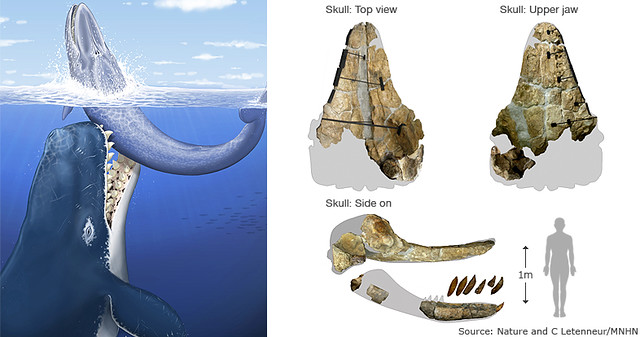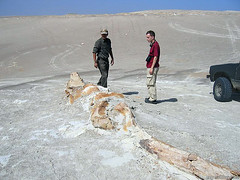Fierce sea monster fossil found in Peru
Peru’s dry coastal desert, once part of the Pacific seabed, has offered up another fabulous discovery for the fossil hunters who roam the area, known to be the final resting place of many ancient sea creatures.
Researchers lead by the Natural History Museum of Paris’s Dr Christian de Muizon made a great discovery in 2008. After intense study the team have published their findings in the science journal Nature.
They’ve dubbed the 12 million year old creature “Leviathan”, though due to its size it has also been called the “sea monster”. Studies have extrapolated from the size of its skull, the only part found, that it would have been around 17 metres long, looking a lot like a modern sperm whale. But unlike the passive sperm whale, the Leviathan had huge jaws and teeth as large as a human forearm with outstretched hand included.

An aggressive predator, it is likely to have fed on other large whales, anything 8 metres long or less. Its teeth would have ripped anything it bit into to shreds in seconds.
Not myth nor legend
“It was a kind of sea monster,” Muñoz wrote.
“And it’s interesting to note that at the same time in the same waters was another monster, which was a giant shark about 15m long. It’s possible that they might have fought each other”.
Dr Olivier Lambert, part of the team sent to Peru, was there the day they found the huge 3-metre long fossilised skull.
 “It was the last day of our field trip when one of our colleagues came and told us that he thought he’d found something very interesting. So we joined him and he showed it to us,” he told the BBC.
“It was the last day of our field trip when one of our colleagues came and told us that he thought he’d found something very interesting. So we joined him and he showed it to us,” he told the BBC.
“We immediately saw that it was a very large whale and when we looked closer we saw it was a giant sperm whale with huge teeth.”
The team had speculated that an animal of this size had once existed based on previous teeth finds that couldn’t be attributed to any other creature. The teeth on this sperm-whale-like creature were more than twice the size as those on a modern sperm whale, and this animal had teeth on both jaws as opposed to a sperm whale that only has teeth on its lower jaw.
The excited researchers had finally found what was until then the stuff of myth and legend. It is not known why the Leviathan died out, but it could be due to environmental changes, perhaps leading to the emergence of today’s sperm whale.




![Peru’s patent win strikes blow against biopiracy [Featured]](http://farm4.static.flickr.com/3213/3119559648_54f3119415.jpg?v=0)





